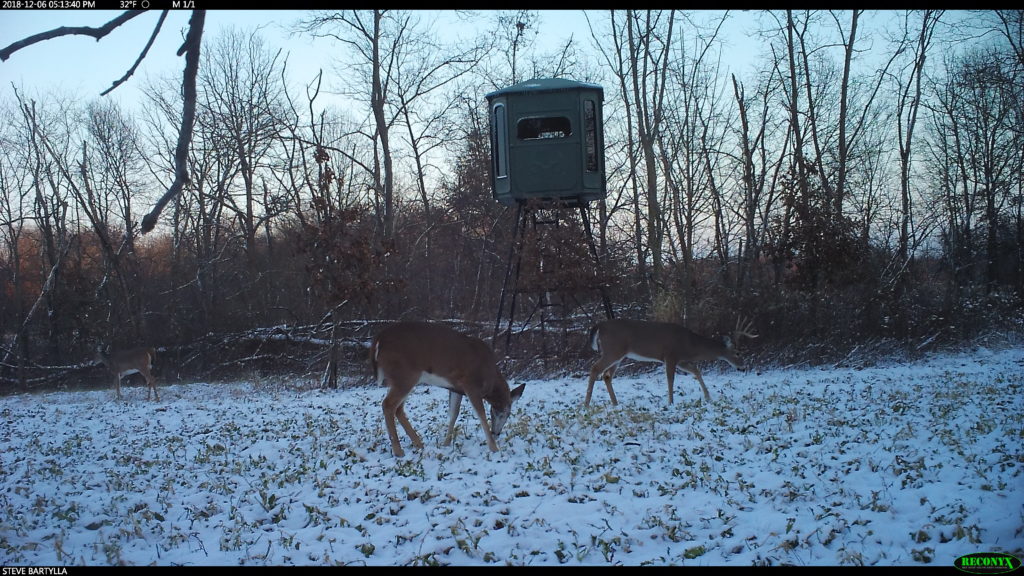Many believe that deer, particularly bucks, are programmed to shift core areas with the seasons. Frankly, it happens in many settings, every year. Understanding them can be key to scoring on shifting bucks or stopping them from shifting with the seasons altogether.
This is Chapter 5 of Steve Bartylla’s free online book, Understanding Mature Bucks.
We were just discussing how to anticipate annual shifts in feeding activities based on learning our food sources’ desirability stages, growth stages and availability, combined with learning the historical feeding patterns on one’s hunting grounds. We do that, which most all of us are capable of doing, and, within a few years, we’re able to anticipate when deer will generally be feeding on what and even where. Obviously, that’s a potentially very powerful hunting tool, and one that I’ve used to tag a good number of mature bucks over the years.
This chapter, let’s look at seasonal shifts. Right off the bat, many mistakenly believe that bucks are preprogrammed to have distinctly different winter, spring, summer and fall ranges, often miles apart. Don’t get me wrong, that exact thing or close variations do play out in many areas whitetails call home.
For example, in regions experiencing truly significant winters (generally talking somewhere over a half foot of snow on the ground for 3+ month stretches, at a bare minimum), deer will migrate long distances to winter in traditional overwinter yarding areas. That is a very natural act, for those areas, that we really don’t want to change, even if we feasibly can on a micro level.
A lot of properties in predominantly ag country, with comparatively less year-round deer cover, go through very significant shifts with the crops. Once crops get a few feet high, the big picture of the area goes from comparatively very little deer cover to suddenly an endless surplus. Forget about the obvious examples of deer bedding in crops and along fence lines they never would after crops are harvested. Think about all those less than 2-acre pockets of cover. When crops aren’t present, they are potentially dangerous places to be. The deer get booted and they’re running a long way across the wide open, an act that seemingly and understandably terrorizes deer. With the crops being 3+ feet tall, one jump and they’re in the middle of miles of cover. What was otherwise horrible bedding can be five stars, when surrounded by cover providing crops.

Another common occurrence is the formation of summer bachelor groups of bucks. From fawn birth on through the first few months of life, most experienced does are actively driving bucks and other deer away from where they stash their fawns. At the same time, most likely due to bugs, which are actually a major source of stress for deer and causes far more death than most likely realize, and having sensitive velvet covering their growing antlers, bucks don’t seem to prefer summering in thick cover. Top all of this off with testosterone levels being comparatively low, resulting in increased tolerance for male companionship, and the bucks have the opportunity to peaceably work out a hierarchy of dominance within the group. I believe this is very important, as every true buck fight in the fall is a life or death ordeal. Frankly, I believe most bucks want to avoid fights, if they can, and the summer bachelor groups are preemptive measures for doing so. Often, these groupings draw bucks a considerable distance from where they historically spend their falls.
As a potentially interesting side note, many believe that the does are drawing the bucks back in the fall. The reality is that the last bachelor groups generally break up for good, just as peak scraping phase has 1–3 weeks left. That’s where dominance really starts playing out, and that happens to be next week’s topic.
That said, by understanding the seasonal shifting occurring on our grounds, we can anticipate them every bit as well as we can the changing food sources. In fact, often within a day or two, you’ll see the same shifting occurring year to year to year to year. Knowing the why, where and when is another set of potentially powerful hunting tools in our arsenals.
I’ll wrap up with the myth portion of all of this. Outside of migrating to traditional overwintering grounds, the bucks aren’t preprogrammed at all to shift from summer to fall to winter to spring ranges. Instead, their needs are merely changing with the seasons. If you want the bucks to stick on your ground year round, merely offer everything they want in each season on that dirt. One can and should debate if that makes sense in specific situations, but that doesn’t change the fact that one can accomplish just that, assuming they have the acreages, habitat and desire to pull it off.
Read Chapter 1: Whitetail Tendencies
Read Chapter 2: Whitetail Home Ranges
Read Chapter 3: How Deer Use Core Areas


